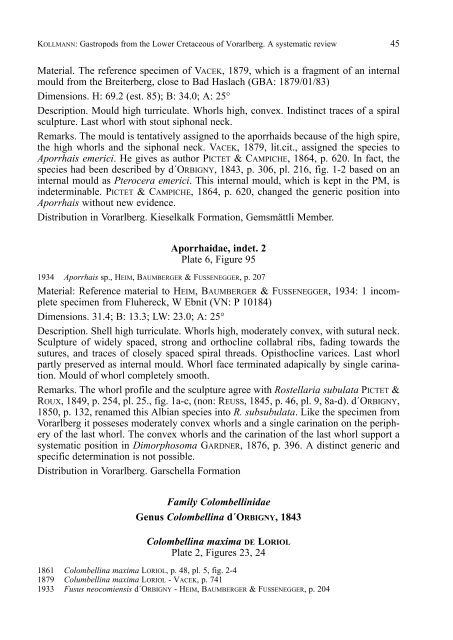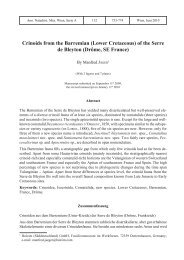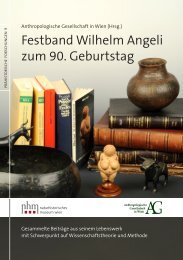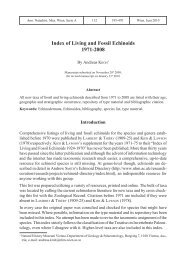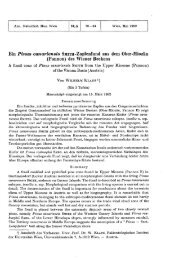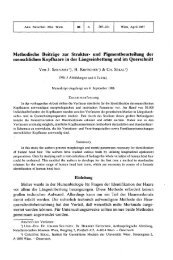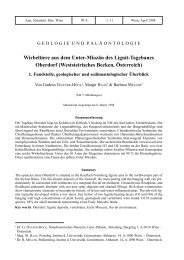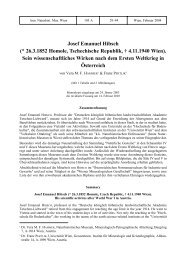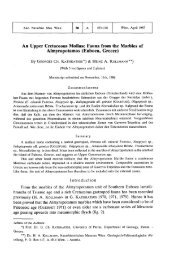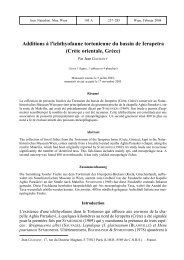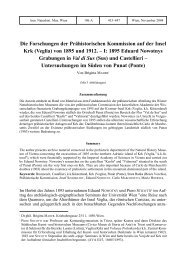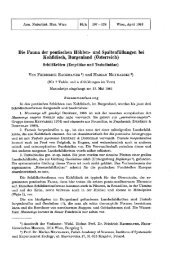Gastropods from the Lower Cretaceous of Vorarlberg, Austria. A ...
Gastropods from the Lower Cretaceous of Vorarlberg, Austria. A ...
Gastropods from the Lower Cretaceous of Vorarlberg, Austria. A ...
You also want an ePaper? Increase the reach of your titles
YUMPU automatically turns print PDFs into web optimized ePapers that Google loves.
KOLLMANN: <strong>Gastropods</strong> <strong>from</strong> <strong>the</strong> <strong>Lower</strong> <strong>Cretaceous</strong> <strong>of</strong> <strong>Vorarlberg</strong>. A systematic review 45<br />
Material. The reference specimen <strong>of</strong> VACEK, 1879, which is a fragment <strong>of</strong> an internal<br />
mould <strong>from</strong> <strong>the</strong> Breiterberg, close to Bad Haslach (GBA: 1879/01/83)<br />
Dimensions. H: 69.2 (est. 85); B: 34.0; A: 25°<br />
Description. Mould high turriculate. Whorls high, convex. Indistinct traces <strong>of</strong> a spiral<br />
sculpture. Last whorl with stout siphonal neck.<br />
Remarks. The mould is tentatively assigned to <strong>the</strong> aporrhaids because <strong>of</strong> <strong>the</strong> high spire,<br />
<strong>the</strong> high whorls and <strong>the</strong> siphonal neck. VACEK, 1879, lit.cit., assigned <strong>the</strong> species to<br />
Aporrhais emerici. He gives as author PICTET & CAMPICHE, 1864, p. 620. In fact, <strong>the</strong><br />
species had been described by d´ORBIGNY, 1843, p. 306, pl. 216, fig. 1-2 based on an<br />
internal mould as Pterocera emerici. This internal mould, which is kept in <strong>the</strong> PM, is<br />
indeterminable. PICTET & CAMPICHE, 1864, p. 620, changed <strong>the</strong> generic position into<br />
Aporrhais without new evidence.<br />
Distribution in <strong>Vorarlberg</strong>. Kieselkalk Formation, Gemsmättli Member.<br />
Aporrhaidae, indet. 2<br />
Plate 6, Figure 95<br />
1934 Aporrhais sp., HEIM, BAUMBERGER & FUSSENEGGER, p. 207<br />
Material: Reference material to HEIM, BAUMBERGER & FUSSENEGGER, 1934: 1 incomplete<br />
specimen <strong>from</strong> Fluhereck, W Ebnit (VN: P 10184)<br />
Dimensions. 31.4; B: 13.3; LW: 23.0; A: 25°<br />
Description. Shell high turriculate. Whorls high, moderately convex, with sutural neck.<br />
Sculpture <strong>of</strong> widely spaced, strong and orthocline collabral ribs, fading towards <strong>the</strong><br />
sutures, and traces <strong>of</strong> closely spaced spiral threads. Opisthocline varices. Last whorl<br />
partly preserved as internal mould. Whorl face terminated adapically by single carination.<br />
Mould <strong>of</strong> whorl completely smooth.<br />
Remarks. The whorl pr<strong>of</strong>ile and <strong>the</strong> sculpture agree with Rostellaria subulata PICTET &<br />
ROUX, 1849, p. 254, pl. 25., fig. 1a-c, (non: REUSS, 1845, p. 46, pl. 9, 8a-d). d´ORBIGNY,<br />
1850, p. 132, renamed this Albian species into R. subsubulata. Like <strong>the</strong> specimen <strong>from</strong><br />
<strong>Vorarlberg</strong> it posseses moderately convex whorls and a single carination on <strong>the</strong> periphery<br />
<strong>of</strong> <strong>the</strong> last whorl. The convex whorls and <strong>the</strong> carination <strong>of</strong> <strong>the</strong> last whorl support a<br />
systematic position in Dimorphosoma GARDNER, 1876, p. 396. A distinct generic and<br />
specific determination is not possible.<br />
Distribution in <strong>Vorarlberg</strong>. Garschella Formation<br />
Family Colombellinidae<br />
Genus Colombellina d´ORBIGNY, 1843<br />
Colombellina maxima DE LORIOL<br />
Plate 2, Figures 23, 24<br />
1861 Colombellina maxima LORIOL, p. 48, pl. 5, fig. 2-4<br />
1879 Columbellina maxima LORIOL - VACEK, p. 741<br />
1933 Fusus neocomiensis d´ORBIGNY - HEIM, BAUMBERGER & FUSSENEGGER, p. 204


